
The Office of Strategic Services (OSS) was the intelligence agency of the United States during World War II. The OSS was formed as an agency of the Joint Chiefs of Staff (JCS) to coordinate espionage activities behind enemy lines for all branches of the United States Armed Forces. Other OSS functions included the use of propaganda, subversion, and post-war planning.
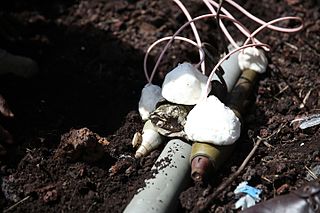
Plastic explosive is a soft and hand-moldable solid form of explosive material. Within the field of explosives engineering, plastic explosives are also known as putty explosives or blastics.
Special Operations Executive (SOE) was a British organisation formed in 1940 to conduct espionage, sabotage and reconnaissance in German-occupied Europe and to aid local resistance movements during World War II.
The Auxiliary Units, Home Guard Shock Squads or GHQ Auxiliary Units were specially trained, highly secret quasi military units created by the British government during the Second World War with the aim of using irregular warfare in response to a possible invasion of the United Kingdom by Nazi Germany, "Operation Sea Lion". With the advantage of having witnessed the rapid fall of several Continental European nations, the United Kingdom was the only country during the war that was able to create a multilayered guerrilla force in anticipation of an invasion.

The Norwegian heavy water sabotage was a series of Allied-led efforts to halt German heavy water production via hydroelectric plants in Nazi Germany-occupied Norway during World War II, involving both Norwegian commandos and Allied bombing raids. During the war, the Allies sought to inhibit the German development of nuclear weapons with the removal of heavy water and the destruction of heavy-water production plants. The Norwegian heavy water sabotage was aimed at the 60 MW Vemork power station at the Rjukan waterfall in Telemark.

The Welrod is a British bolt action, magazine fed, suppressed pistol devised during the Second World War by Major Hugh Reeves at the Inter-Services Research Bureau. Station IX, being based near Welwyn Garden City, gave the Welrod its unusual name, being derived from "Wel" from "Welwyn Garden City" and "rod", gangland slang for gun, as a way to obscure its purpose.
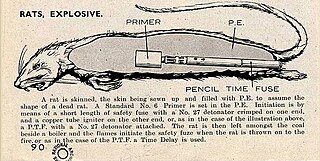
The explosive rat, also known as a rat bomb, was a weapon developed by the British Special Operations Executive (SOE) in World War II for use against Germany. Rat carcasses were filled with plastic explosives, and were to be distributed near German boiler rooms where it was expected they would be disposed of by burning, with the subsequent explosion having a chance of causing a boiler explosion.
A limpet mine is a type of naval mine attached to a target by magnets. It is so named because of its superficial similarity to the shape of the limpet, a type of sea snail that clings tightly to rocks or other hard surfaces.

Éliane Sophie Plewman was a British agent of the Special Operations Executive (SOE) and a member of the French Resistance working as a courier for the "MONK circuit" in occupied France during World War II. SOE's objective was to conduct espionage, sabotage and reconnaissance against the Axis Powers, especially Nazi Germany in occupied Europe and to aid local resistance movements. Plewman was captured by the Gestapo, and later executed by the SS in Dachau.

Aston is a village and civil parish in the East Hertfordshire district of Hertfordshire, England. According to the 2001 census it had a population of 844, increasing to 871 at the 2011 Census. Located on a ridge between Stevenage and the Beane Valley, Aston is a 10 minutes drive from the A1(M).
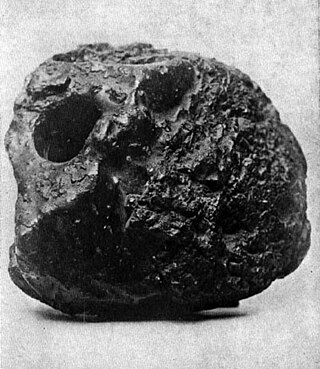
The coal torpedo was a hollow iron casting filled with explosives and covered in coal dust, deployed by the Confederate Secret Service during the American Civil War, and intended for doing harm to Union steam transportation. When it was shoveled into the firebox amongst the coal, the resulting explosion would at the very least damage the boiler and render the engines inoperable. At worst, a catastrophic boiler explosion would kill crewmen and passengers, start a fire, or even sink the vessel.
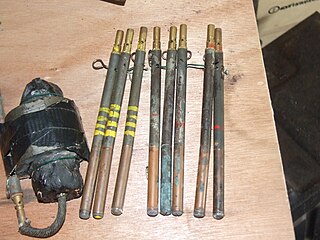
A pencil detonator or time pencil is a time fuze designed to be connected to a detonator or short length of safety fuse. They are about the same size and shape as a pencil, hence the name. They were introduced during World War II and developed at Aston House, Hertfordshire, UK.

Lise Marie Jeanette de Baissac MBE CdeG, code names Odile and Marguerite, was a Mauritian agent in the United Kingdom's clandestine Special Operations Executive (SOE) organization in France during World War II. The purpose of SOE was to conduct espionage, sabotage, and reconnaissance in countries occupied by the Axis powers, especially Nazi Germany. SOE agents allied themselves with resistance groups and supplied them with weapons and equipment parachuted in from England.
John Robert Vernon Dolphin was a British engineer and inventor, who joined the Secret Intelligence Service and then became the Commanding Officer of the top-secret Second World War Special Operations Executive (SOE) "Station IX", where specialist military equipment was developed. During his time there his inventions included the Welman submarine and the Welbike.
Major Cecil Vandepeer Clarke MC (1897–1961) was an engineer, inventor and soldier who served in both the First and Second World Wars.
Station IX was a secret British Special Operations Executive factory making special weapons and equipment during World War II.
Operation Josephine B was a military mission in June 1941 during the Second World War. The mission was organised jointly by the Free French and the British Special Operations Executive (SOE), together with the Royal Air Force for air drops. The operation was initially stalled by a lack of up-to-date information, but ultimately succeeded in its main objective, the destruction of an electrical transformer station in Pessac, near Bordeaux.

Wanborough Manor is an Elizabethan manor house on the Hog's Back in Wanborough in the Borough of Guildford, Surrey. During World War II the manor house was requisitioned by the Special Operations Executive (SOE) to train secret agents and was known as Special Training School 5 and later returned to private ownership.
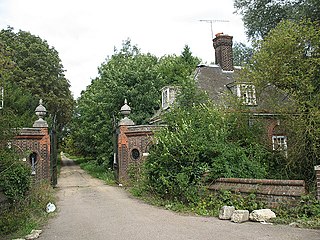
Briggens House is a Grade II listed 18th-century house and parklands near the village of Roydon, Essex, England. It has a number of features from the garden designer Charles Bridgeman from 1720. There are also some remains of the pleasure gardens developed by Lord Hunsden in 1908.












